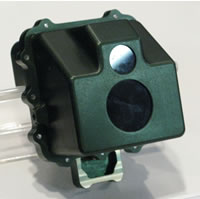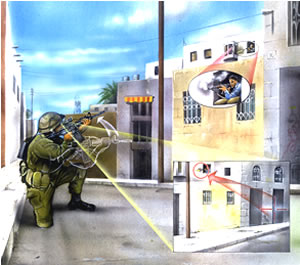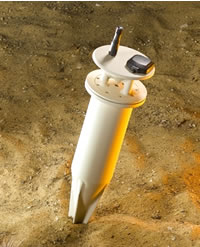IAI/Elta is showing a new range of unattended ground sensors and Short-Wave Infrared (SWIR) based sensors based on the EL/L-8293 Transient Event Detection (TED) developed by a new subsidiary called OptigO and the EL/I-6001UGSN is a modular network of autonomous distributed sensors including seismic, acoustic, electro-optical sensors and miniature ground surveillance radars.
The new network is part of Israel Aerospace Industries’ product offering for the evolving requirements for improving forward operating bases, force protection, and border security. Among these are security systems based a range of autonomous, unmanned ground vehicles, systems developed under collaboration with Elbit Systems, at the G-NIUS Unmanned Ground Vehicles company.
 IAI/Elta is showing a new range of unattended ground sensors and Short-Wave Infrared (SWIR) based sensors based on the EL/L-8293 Transient Event Detection (TED) developed by a new subsidiary called OptigO. TED operates as a persistent, day and night, multi-wave Infra-Red electro-optical(E/O) surveillance system designed to effectively detect IR transients over a wide field of view. The new device is capable of automatically detecting enemy gunshot by azimuth and elevation, covering a large area within a wide field of regard (FOR), enabling fast and effective response toward the gunshot source. TED is confugured as a lightweigt soldier portable or vehicle mounted device, It can operate effectively in open areas, urban areas, quiet or noisy environments, stationary or on-the-move. TED can also be associated as part of the EL/I-6001 Unattended Ground Sensors Network (USGN) developed by Elta Systems.
IAI/Elta is showing a new range of unattended ground sensors and Short-Wave Infrared (SWIR) based sensors based on the EL/L-8293 Transient Event Detection (TED) developed by a new subsidiary called OptigO. TED operates as a persistent, day and night, multi-wave Infra-Red electro-optical(E/O) surveillance system designed to effectively detect IR transients over a wide field of view. The new device is capable of automatically detecting enemy gunshot by azimuth and elevation, covering a large area within a wide field of regard (FOR), enabling fast and effective response toward the gunshot source. TED is confugured as a lightweigt soldier portable or vehicle mounted device, It can operate effectively in open areas, urban areas, quiet or noisy environments, stationary or on-the-move. TED can also be associated as part of the EL/I-6001 Unattended Ground Sensors Network (USGN) developed by Elta Systems. 
Elta’s new UGSN is a modular network of autonomous distributed sensors including seismic, acoustic, electro-optical sensors and miniature ground surveillance radars. Each sensor includes a sensitive microphone, for acoustic detection, a geophone picking up seismic vibration from nearby movement, a GPS receiver, communications transceiver and low-power controller and signal processor.
The sensor can pick up moving heavy vehicles (such as tanks) from a distance of 500 meters and walking humans from 50 meters. The UGS can be configured with high capacity power module for extended use (four weeks), or in a miniature casing, for short missions (7 days). Surveillance data is transmitted wirelessly, through self-forming network to te ground command and control center. The UGS can be located in any area for monitoring the area of interest for an extended period of time. The sensors can operate autonomously or in combination, optimizing area coverage, and facilitating target detection, classification. Add-on electro-optical sensors such as TED based passive, uncooled thermal sensors, can be added. While TEDs are maintained in power saving ‘sleep mode’, they automatically designated by the UGS to perform target recognition and identification.
















